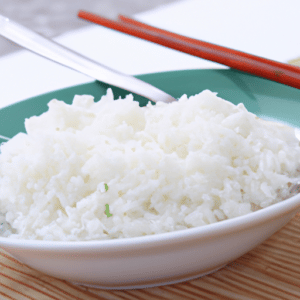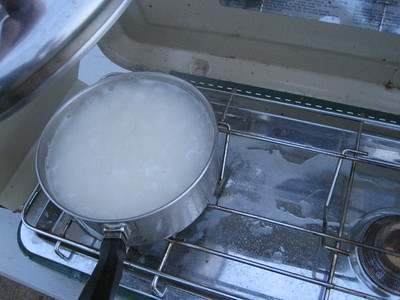So you want to learn how to cook rice without a rice cooker because, let’s be honest, not everyone has a rice cooker in their kitchen.
The main concern is that it takes real skill to be able to cook rice correctly without a rice cooker. Wrong measurements and inaccurate timings can lead to producing something that is sloshy and gloopy. Nobody wants that to happen.
Cooking Your Rice
Uncooked rice, or even overcooked rice, is never a good thing. However, if you can follow these next few steps, there’s no reason you cannot end up with some cooked rice that you can be proud of.
Step 1: The Type of Rice
One of the first things you need to realise about preparing rice is that brown rice is different from white rice, and we don’t just mean the colour.
Different types of rice will take different lengths of time when it comes to the cooking aspect. The key to successfully making rice is to understand how long it takes for you to get that perfect fluffy rice.
Basmati rice, a type of long-grain rice or any other white rice, may take around 12 minutes to cook, with some variation in that time. However, brown rice will usually take over 20 minutes to cook.
This is all due to the differences in rice grains, which influence the ability to cook rice perfectly.
You should pay attention to your rice and learn the expected cooking time before starting.
Step 2: Measure Your Quantity of Rice
The next step in cooking without a rice cooker is to measure the quantity of rice depending on what you need.
This is where you need to pay attention to your recipe, but generally speaking, somewhere in the 75g is often regarded as being one portion of rice.
However, this will change if you look at sushi rice or short-grain rice as an example, so you need to look at the desired quantity once again.
Step 3: Wash the Rice
This is an important step in making rice, but it’s best to wash rice before cooking to get the perfect rice.
By rinsing rice, you will remove starch outside the grains. Rinse the rice well, as it’s capable of making a significant difference to the result.
Afterwards, you should put your rice into a colander and run water through it until it begins to run clear.
Step 4: The Rice-to-Water Ratio
It would help if you had the correct freshwater-to-rice ratio as you make rice in water. Too much water will undoubtedly lead to rice that is overcooked and mushy.
It just takes on too much water, which will ruin any meal. If you want to cook perfect rice without a rice cooker, consider the rice-to-water ratio.
You are looking at a 2:1 ratio of water to rice. Some people prefer to reduce this to a 1:1 ratio, but 2:1 is also widely used.
Step 5: Letting Your Rice Soak
After measuring the water, you will need to allow the rice to soak to get a bowl of good steamed rice.
Once again, this varies, and some believe that when cooking white rice, you need to soak it for different times to brown rice, but it will be around 20 minutes.
Please do this in the pot where you plan to cook your rice and put the lid on it.
Step 6: Managing to Cook Perfect Rice

After this time has passed, it’s now the right time to cook white rice. The key is to boil the water, but when it has come to a boil, you need to turn it down to medium-high heat. However, some will argue that you should put the heat even lower.
Avoid the water from splashing up and over the edges of the pot, so keep an eye on it as it cooks.
This part of the process should take around 12 minutes for long-grain rice. However, if you are making Japanese rice, brown rice, long-grain rice or something else, make sure you cook it at the correct time.
With this step, it’s best if you don’t remove the lid. You want the steam and water to cook rice without being interrupted effectively.
Getting It Right
You will know how to cook the perfect rice by following these steps. However, there are a few additional tips you may want to know.
Tip 1: Don’t Stir
The first tip on how to cook rice without a rice cooker is never to stir with a rice paddle during the cooking process. You must leave it to sit there and get on with the cooking process without interrupting it.
Tip 2: Don’t Think All Rice Is the Same
When it comes to cooking rice, some people believe that you can use any rice.
While that may be partly true, some differences change how you make fried rice to sticky rice and rice balls.
Brown rice takes longer to cook as it has a hard outer shell still on the grain. That means it takes more power to get through the shell and make it soft to eat.
That is one example of how you need to change the cooking time and, in this instance, also change the amount of water.
Tip 3: Cooking at the Right Temperature
No matter what type of rice you use, you will need to be careful about the temperature you are cooking.
The wrong temperature will lead to you cooking off the water before the rice is done, and that will lead to you burning your rice and causing it to stick to the bottom of the pan.
Japanese cooking methods will often talk about medium heat, but if you want to cook on gas, use the smallest ring and keep it low after boiling water.
Tip 4: Using a Microwave
If you don’t feel like using the stove, you can use the microwave method. You need to add the right water-to-rice ratio, as always, and then cook on high heat for around 5 minutes. It may take some getting used to the microwave, but it does work.
Tip 5: Your Pot
You don’t need a large pot to cook rice successfully if you use a stove. While some traditional methods use a clay pot, that’s also unnecessary.
However, it will be useful to have a pot with a glass lid. That means you can keep an eye on things while the rice is cooking, and you will know if you are running out of water and misjudged things.

Tip 6: Trying to Reheat Rice
If you wish to reheat cold rice, all required is a splash of water, depending on the quantity, and then add some heat.
The water is important, as it will rehydrate the rice a bit and allow the grains to come apart.
You can add it to the microwave and cook it for around 3 minutes. Check that the rice is piping hot before you serve.
Why You May Not Need a Rice Cooker
Finally, if all of this sounds like it’s too easy for things to go wrong, you have a rice cooker option available.
However, the key to cooking rice on the stove is to ensure that the rice has been rinsed, drained, and then added the right amount of water.
And that is how you are going to be able to cook rice without using a rice cooker. You could make life easier for yourself by investing in a good rice cooker, but don’t worry if that’s not an option, as getting wonderful rice with or without a rice cooker is still possible.
On the other hand, practice does make everything perfect, and if you prefer to keep a close eye on things, then rice cooking is something you can do quite easily at home.

